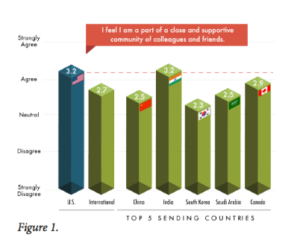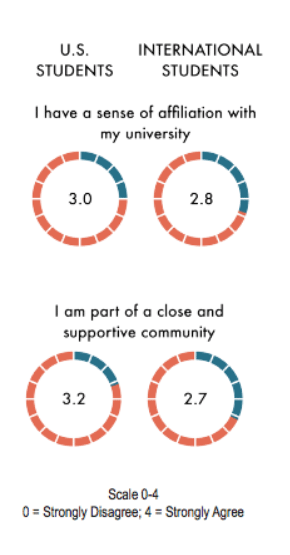One aspect of what’s missing and what Matters to International students is a sense of community.
This blog post quotes several studies and papers to talk about this topic.
Lacking Sense of Community:
International students rate their sense of community significantly lower than their U.S. peers, especially when asked whether they feel part of a close and supportive community of colleagues and friends at their institution.
One of the most significant concerns reported in research on diversity and integration issues in higher education is the lack of social interaction and the sense of social isolation that many international students experience while abroad.
Overall, international students rated their sense of social connection significantly lower than their U.S. peers (see Figure 1). This lack of social connection was particularly pronounced for students from China, Saudi Arabia, and South Korea. Students from India, in contrast, reported the same levels of social connection to their U.S. peers as their American student counterparts probably due to the large Indian student population at most U.S. campuses.

In search of better social environment:
A strong sense of community is essential for improved academic performance. One of the most striking findings of one study was how detached many of the international students surveyed felt from their respective institutions and the larger university community.
Educational institutions are inherently about relationship-building. However, many international students live in “separate but equal” worlds, cut off from meaningful interaction with their American student peers.
It was found that reports of unmet expectations and dissatisfaction with the U.S. university experience are on the rise among international students in the U.S.

Decline in international student enrollment:
On campuses where international students rated their sense of community as significantly lower than their U.S. peers, they also reported a weaker affiliation with their universities; were less likely to agree that their campus honors diversity and internationalism; were less clear on the mission of their university; felt less challenged and supported, and were less likely to believe that their strengths and talents had been adequately developed.
It is of no surprise that these institutions that fail to provide social and academic support for international students are seeing a real decline in international student retention rates.
Student Mobility Trends:
Although the United States remains the leading educational destination of globally mobile students, its market share of international students has actually dropped from 23% to 17% in the last ten years.
Environments That Enhance The International Student Experience:
Universities invest large sums of money in recruitment. These efforts should now be matched by more earnest and concentrated efforts to strengthen sense of community among the large international student population upon which U.S. institutions increasingly rely.
Social and psychological influences in a student’s life play an important part in student development. No one lives in a vacuum, immune to external expectations, norms, modes of behavior, family and social influences, etc.
Digital Communities:
Today, the college community has expanded beyond the physical setting of a campus, students are quite at ease with building relationships over the Internet; the idea of digital communities is on the rise.
These digital communities breakdown physical and other antiquated barriers of the past that have not allowed international students to create stronger bonds with a larger student community at their campus and beyond. More importantly, these digital communities can forge relationships between international and U.S. students that are quite weak or nonexistent across many campuses.
Alumni and Digital Communities:
One other positive aspect of a digital community is to stay engaged with alumni who leave the physical boundaries of the campus after graduation. Alumni have a strong emotional ties to their alma mater but get busy with making a future. A campus’s digital community can provide that social bridge and keep alumni tethered to their place of study. It can be a strong bond for both parties.
It must therefore be the responsibility not only of individual students, but also of the institutions serving them, to create environments, digital and otherwise, that deliver on the promises made in term of the benefits of campus diversity and internationalization.

I can totally relate to this article as a foreign student myself. The biggest factor was finding a community of other students in the same boat.
nice writeup